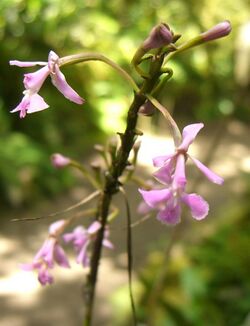Biology:Epidendrum blepharistes
| Epidendrum blepharistes | |
|---|---|

| |
| Scientific classification | |
| Kingdom: | Plantae |
| Clade: | Tracheophytes |
| Clade: | Angiosperms |
| Clade: | Monocots |
| Order: | Asparagales |
| Family: | Orchidaceae |
| Subfamily: | Epidendroideae |
| Genus: | Epidendrum |
| Subgenus: | Epidendrum subg. Amphiglottium |
| Section: | Epidendrum sect. Polycladia |
| Species: | E. blepharistes
|
| Binomial name | |
| Epidendrum blepharistes Barker ex Lindl. (1844)
| |
| Synonyms | |
| |
Epidendrum blepharistes is a species of orchid in the genus Epidendrum native to Bolivia, Colombia, Costa Rica, Ecuador, Peru, and Venezuela.[1]
Description
Epidendrum blepharistes grows both terrestrially and epiiphytically at altitudes ranging from 1.0 km to 3.0 km in the Neotropics.[2] Like other members of the subgenus E. subg. Amphiglottium, E. blepharistes exhibits a sympodial growth habit, with individual stems covered from the base with close, tubular sheaths; on the upper part of the stem, these sheaths are the bases of the distichous leaves. E. blepharistes differs from most members of E. subg. Amphiglottium by frequently having a fusiform swelling, up to 1.5 dm long, at the base of each stem. The elongate, ovate, obtuse leaves[3] can grow more than 22 cm long by 3 cm wide. The terminal peduncle is covered from its base in close tubular sheaths, and carries either a loose panicle (typical of the section E. sect. Polycladia) consisting of rather few distant racemes, or a single raceme. The small flowers are a rich rose color with oval sepals up to 10 mm long by 4 mm wide, acuminate petals nearly the same length as the sepals but with a denticulate margin, and a quadrilobate lip which is adnate to the column to its apex. (Schweinfurth 1959 describes the lip as "deeply 3-lobed" and then describes the mid-lobe as "deeply bilobed at the apex".) The lateral lobes of the lip are more or less fringed. There are two calli where the lip diverges from the column, and a keel between them, running part way down the medial lobe of the lip.
The diploid chromosome number of E. blepharistes has been determined as 2n = 40.[4]
References
- ↑ "World Checklist of Selected Plant Families: Royal Botanic Gardens, Kew". http://apps.kew.org/wcsp/namedetail.do?accepted_id=67918&repSynonym_id=-9998&name_id=67918&status=true.
- ↑ Schweinfurth. "Orchids of Peru" Fieldiana: Botany 30(1959)446—7. Field Museum, Chicago, IL. as Epidendrum funkii
- ↑ H. G. Reichenbach, "Orchides", nr. 236 in C. Müller, Ed. Walpers Annales Botanices Systematicae 6(1861)411. Berlin.
- ↑ page 251 of Leonardo P. Felix and Marcelo Guerra: "Variation in chromosome number and the basic number of subfamily Epidendroideae (Orchidaceae)" Botanical Journal of the Linnean Society 163(2010)234-278. The Linnean Society of London. downloaded October 2010 from http://onlinelibrary.wiley.com/doi/10.1111/j.1095-8339.2010.01059.x/pdf
External links
- The Internet Orchid Species Photo Encyclopedia
- http://maqui.ucdavis.edu/Images/Orchids/epidendrum_blepharistes.html
- http://fm2.fieldmuseum.org/plantguides/guide_pdfs/166%20Maquipucuna%20orchids.pdf
- picture of herbarium sheet: http://orchid.unibas.ch/phpMyHerbarium/3130/1////specimen.php
- holotype of E. dolabrilobum herbarium sheet pictures: http://asaweb.huh.harvard.edu:8080/databases/specimens?id=110482
Wikidata ☰ Q5382740 entry
 |

